Bulletin – December 2010 Trends in Farm Sector Output and Exports
Abstract
Over time, the size of the farm sector has fallen relative to other sectors in the economy. However, the sector still has an important influence on the nation's pattern of economic growth and its exports. Over the last couple of decades the composition of farm production has moved towards crops and away from livestock. This has had an impact on how drought affects overall farm output, as crop production tends to fall sharply and then recover quickly when the drought breaks, while livestock production is relatively more resilient in the short term but is slower to recover.
Introduction
The farm sector has an important influence on the macroeconomy, despite accounting for around 2½ per cent of nominal GDP over the past decade. Although this is a much smaller share of GDP than in earlier decades, variation in weather conditions makes farm output volatile and this volatility can have significant effects on aggregate GDP growth from year to year (Graph 1). For example, over the past two decades it has not been uncommon for changes in farm production to add (or subtract) almost ½ percentage point to (from) annual GDP growth. In the current financial year, rainfall across many of the major cropping regions in the eastern states has been above average and it is likely that farm output will again make a positive contribution to growth in the overall economy. However, recent flooding in eastern Australia and potential damage from locusts are downside risks to the outlook for farm production. Given the importance of the farm sector, this article discusses recent trends in production and exports, including how patterns of farm production change during periods of drought.
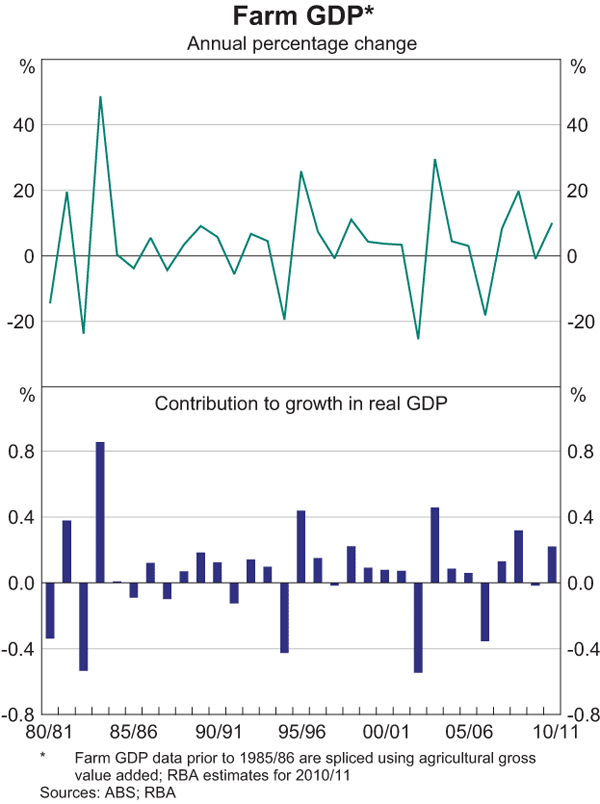
Trends in Production and Exports
In 2009/10, the value of farm production was $23 billion, representing around 2 per cent of nominal GDP. The relative size of Australia's agricultural industry has declined over the past 50 years, with the sector's share of nominal GDP falling from 15½ per cent in 1959/60 to an average of 2½ per cent over the past decade. Employment in the farm sector has also declined relative to the rest of the economy. According to data from the Australian Bureau of Agricultural and Resource Economics and Sciences (ABARES), 10 per cent of Australia's workforce was employed in the farm sector in the early 1960s, or around 440,000 people; this compares with around 325,000 people employed in 2009/10 (or 3 per cent of total employment). Similarly, the share of agriculture-related machinery & equipment investment has declined from around 20 per cent in the early 1960s to an average of 5½ per cent over the past decade.[1] Nonetheless, the farm sector still accounts for a significant share of Australia's goods exports; farm goods accounted for 13 per cent of the value of total goods exports in 2009/10, down from 44 per cent in the 1970s.
Farm production can be decomposed into crops and livestock-related products. Over the past three decades, the share of farm output accounted for by crops has increased from a little under one-half of production to a little over one-half (Table 1). Underlying this increase has been a rise in the importance of crops other than grains, such as fruits, vegetables and nursery crops. Within the livestock industry, the share of meat production has increased relative to other livestock products, such as dairy and wool.
| Crops | Livestock | ||||||
|---|---|---|---|---|---|---|---|
| Grains | Other | Total | Meat production | Other(a) | Total | ||
| 1980s | 24 | 22 | 46 | 26 | 28 | 54 | |
| 1990s | 22 | 30 | 52 | 26 | 22 | 48 | |
| 2000s | 22 | 31 | 53 | 31 | 16 | 47 | |
|
(a) Mostly dairy and wool Source: ABARES |
|||||||
Despite the increase in farm output over the past decade – with average annual growth of around 1½ per cent – rural exports have been broadly unchanged (Graph 2). This divergence partly reflects an increase in domestic consumption of grains, in particular wheat, but also relatively weak growth in those industries that tend to have a high export share of production, namely wool and dairy. As has been the case with production, the composition of exports has shifted towards crops and away from livestock since the 1980s; while the share of rural exports accounted for by meat production has increased, this has been more than offset by a decline in the share of exports accounted for by wool (Table 2).
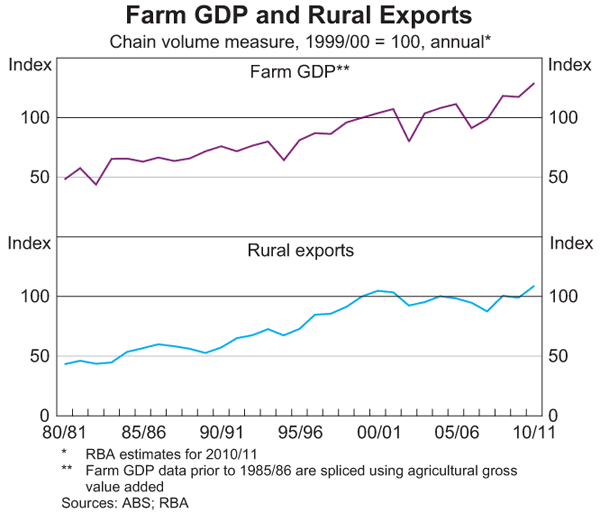
| Crops | Livestock | ||||||
|---|---|---|---|---|---|---|---|
| Grains | Other | Total | Meat production | Other(a) | Total | ||
| 1980s(b) | 24 | 16 | 40 | 20 | 40 | 60 | |
| 1990s | 23 | 23 | 46 | 24 | 30 | 54 | |
| 2000s | 24 | 22 | 45 | 31 | 24 | 55 | |
|
(a) Mostly dairy and wool Sources: ABARES; ABS |
|||||||
Crop production
The mix of crop production has changed noticeably over the past few decades. In the 1980s, the share of total crop production accounted for by grains was broadly similar to that for other crops. However, in the 1990s and 2000s, the production of other crops increased at a faster rate than for grains, driven by strong growth in the production of fruits, vegetables, nursery crops and hay. The increase in fruit production was partly due to an expansion in wine grape production, associated with a surge in wine exports.
The share of grains production that is exported has declined over the past two decades, as growth in domestic demand has outstripped modest growth in production (Table 3 and Graph 3). This decline in the export share of grains production has been driven by wheat and is consistent with an increase in the domestic use of wheat and other grains for animal feed.
| 1980s | 1990s | 2000s | |
|---|---|---|---|
| Grains(b) | 72 | 64 | 61 |
| – Wheat | 82 | 76 | 70 |
| – Coarse grains | 52 | 41 | 45 |
| Wool(c) | 100 | 107 | 111 |
| Meat(d) | 50 | 58 | 62 |
| – Beef | 54 | 62 | 65 |
| – Mutton | 65 | 64 | 75 |
| – Lamb | 15 | 23 | 40 |
| Dairy(e) | 44 | 63 | 63 |
|
(a) Production data are in kilotonnes Sources: ABARES; RBA |
|||
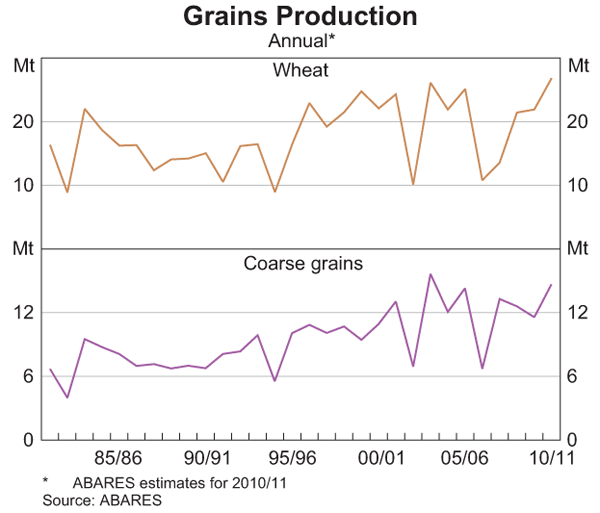
Livestock production
Livestock production as a share of total farm output has fallen over the past three decades, with a decline in other livestock (which includes dairy and wool) more than offsetting a moderate increase in meat production. In the 1990s, other livestock accounted for just over 45 per cent of the value of livestock production, but this fell to just below 35 per cent in the 2000s. A key driver behind this decline has been a sharp fall in wool production, which was around 60 per cent lower in 2009/10 than in 1989/90. The structural decline of the wool industry has been influenced by changes in relative prices; the Australian dollar price of wool has fallen sharply over the past two decades, especially around the collapse of the reserve price wool scheme in the early 1990s, and as demand has shifted towards alternate fibres (Graph 4).
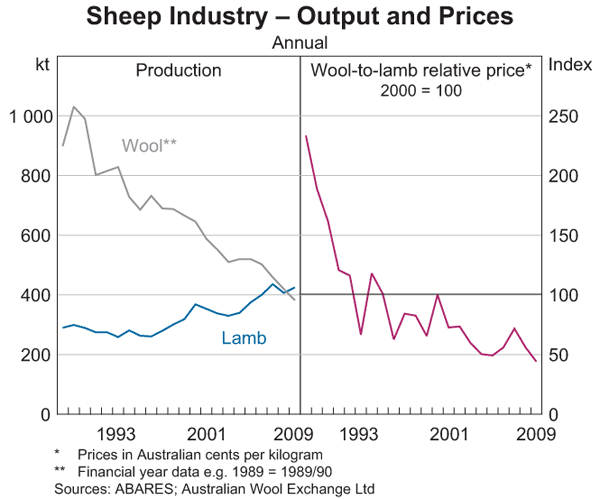
The rising share of meat production also reflects stronger external demand, most noticeably from Asia. The share of beef and veal exports to Asia rose from around 30 per cent in 1988 to a little over 60 per cent in 2008 (Table 4). This was driven by growth in exports to Japan after the removal of Japanese beef import quotas in the early 1990s as well as higher exports to Korea (Nossal, Sheng and Zhao 2008). Growth in beef exports to Asia has also supported the development of the Australian feedlot industry, initially in response to demand for grain-fed beef in Japan. This contributed to ongoing increases in average slaughter weights. As a result, domestic demand for grain has risen, in particular for wheat.
| Export volumes; kt | Share of exports; per cent | ||||||
|---|---|---|---|---|---|---|---|
| 1988 | 1998 | 2008 | 1988 | 1998 | 2008 | ||
| US | 338 | 285 | 235 | 58 | 33 | 25 | |
| Asia | 185 | 427 | 583 | 32 | 50 | 61 | |
| – Japan | 136 | 321 | 364 | 23 | 38 | 38 | |
| – South Korea | 10 | 34 | 127 | 2 | 4 | 13 | |
| Europe | 6 | 54 | 85 | 1 | 6 | 9 | |
| Total | 585 | 855 | 957 | 100 | 100 | 100 | |
|
Source: ABARES |
|||||||
While much smaller than the meat production industry, the live cattle export industry has also experienced rapid growth over the past two decades. This industry is predominantly based in northern Australia, with producers mainly servicing demand from south-east Asian markets. Demand for live cattle has been largely driven by the availability of cheap and abundant feed material in some Asian markets and, to a lesser extent, by demand from traditional ‘wet’ markets (markets without refrigeration, where fresh meat rather than frozen product is sold). Live exports have grown from 110,000 head of cattle in 1989 to around 950,000 cattle in 2009 (Graph 5). The majority of this growth occurred between the early 1990s and the Asian financial crisis in 1997, with demand particularly strong from Indonesia and the Philippines. However, over the past decade, live cattle exports to the Philippines have declined significantly due to a pick-up in meat imports from India and Brazil. In contrast, exports to Indonesia have continued to rise, in part due to Indonesian quarantine measures that restrict beef imports from countries that are not free of foot-and-mouth disease (Martin, Van Mellor and Hooper 2007).[2]
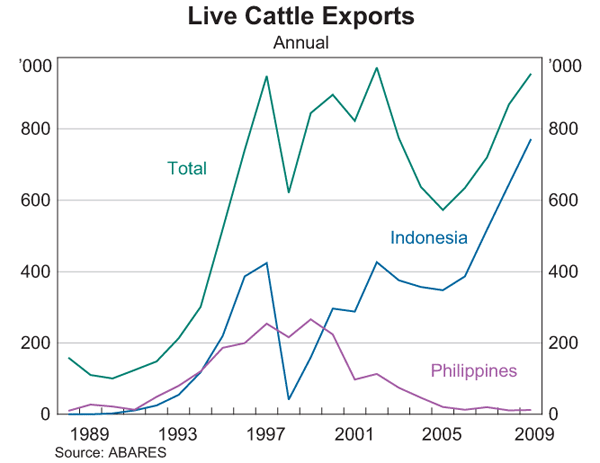
The dairy industry has increased as a share of livestock-related production over the past two decades. Milk production increased strongly from the start of the 1990s until the 2002 drought. During this period there was ongoing deregulation and consolidation within the industry, which resulted in a greater export focus, productivity gains and an increase in milk produced in the predominately export-focused south-eastern states (Graph 6). As a result of these productivity gains and increases in the dairy herd, dairy industry output grew strongly throughout the 1990s and into the 2000s. During this period, output expanded by over 60 per cent while exports more than tripled largely due to increased trade with Asia. In contrast, dairy production has fallen over the past decade as drought noticeably reduced the national herd.
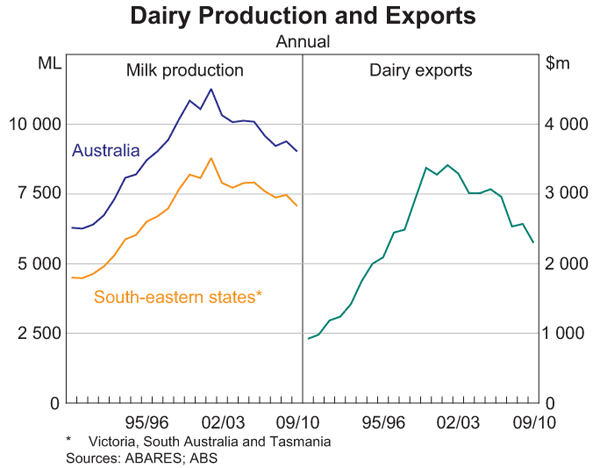
Recent Developments and the Impact of Drought
After difficult conditions over much of the past decade, aggregate farm production is expected to increase solidly in 2010/11, although there are currently significant divergences across the eastern and western parts of the country. A La Niña weather system is firmly established in the Pacific Ocean and, consistent with this, rainfall across many of the major cropping regions in the eastern states has been above average in the second half of 2010. In recent months, inflows to the Murray-Darling basin have increased to be well above long-run average levels; this follows a decade when inflows were the lowest for a century (Graph 7).
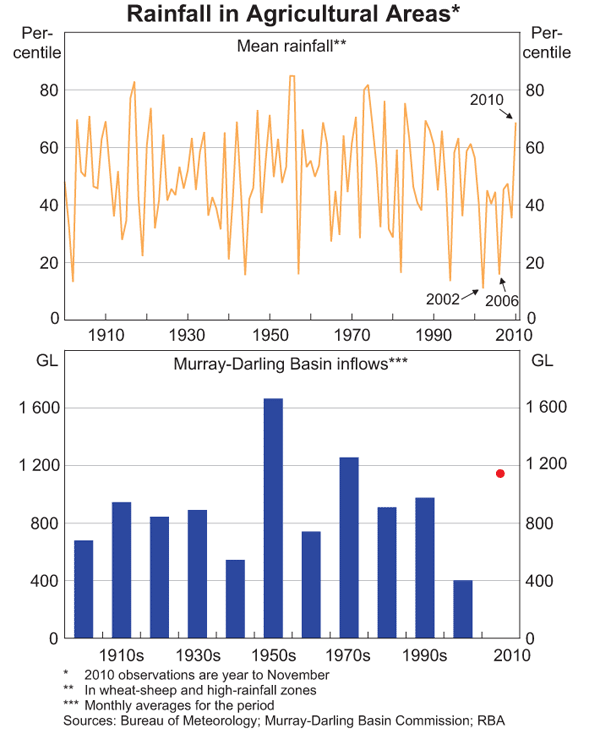
While crop growing conditions in the eastern states had been favourable up until the end of No-vember, recent flooding has caused harvest delays and it is possible that some crops may not be able to be harvested. The flooding will also likely reduce the quality of some crops. However, there is a large degree of uncertainty about the impact of recent adverse weather conditions and, at this stage, ABARES and other forecasters are still forecasting a large increase in the winter crop.
In contrast, most cropping regions in Western Australia have experienced very dry conditions this year and a significant fall in crop production is expected. The improvement in wheat crop yields in the eastern states, however, is expected to offset lower yields in Western Australia (Graph 8). Although potential damage from locust plagues is another downside risk to crop production in the eastern states, in previous episodes spraying of insecticides has reduced damage to crops and pasture. Meat production is expected to remain broadly flat in 2010/11, with good rainfall providing farmers with an incentive to rebuild their herds. Overall, these outcomes are expected to underpin growth in farm GDP of around 10 per cent in 2010/11, contributing around ¼ percentage point to overall GDP growth. This is one of the stronger outcomes in recent times; a larger contribution has been recorded in only five years since 1980.
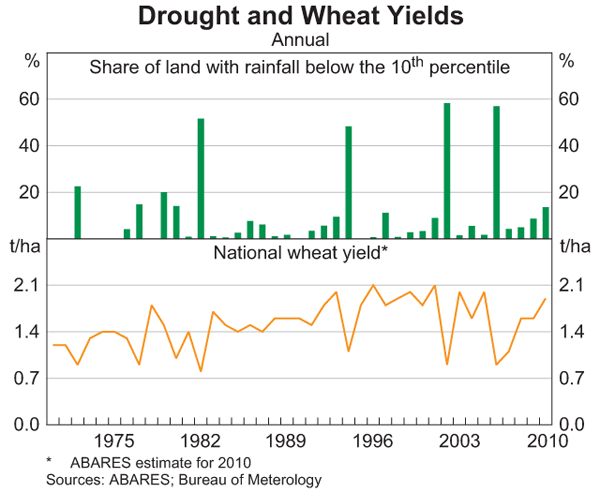
Up until the end of November, developments in the farm sector were fairly typical of those when growing conditions are favourable. However, as is all too familiar in Australia, rural production is affected by drought periods, which typically see farm output fall sharply. For example, farm GDP fell by 18 per cent in 2006/07 due to drought, and increased only moderately in 2007/08 before recovering in 2008/09. This drought was unusually long and farm output bounced back more slowly than following the droughts of 1982, 1994 and 2002. The effect of drought on rural exports tends to be somewhat smaller than its effect on farm GDP, given the build-up of stocks in some industries after good seasonal conditions. Wheat stocks, for example, can grow to about 25 per cent of annual production after a large harvest.
The impact of a drought differs across types of rural production. In the livestock industry, a drought reduces the amount of available pasture, which in turn reduces production per animal. This effect is usually observed over more than one season, and it can be partly offset by the use of supplementary animal feed. Furthermore, as pasture dwindles, farmers tend to reduce herds and, in doing so, contribute to meat production. Livestock production therefore usually falls by less relative to other rural industries during a drought. Similarly, after a drought, the recovery in livestock production tends to be muted, as livestock farmers emerge from drought with fewer animals that are less productive.
In the cropping industry, the impact of drought on production patterns is quite different, with sharp falls and rebounds in production evident. Drought prevents some farmers from sowing seed and it also substantially reduces the volume of crops produced per hectare planted (the crop yield). Thus, production in the cropping industry tends to drop sharply in drought years. However, production can recover quickly as improved rainfall, and an increase in the nitrogen content of the soil – which results if no crop is sown during the drought – can significantly lift the yield. Farmers tend to increase the area they plant in anticipation of this improvement. Further, if the number of animals culled from the livestock industry has been significant, some additional land may be available for planting. Cash flows tend to be generated more quickly in the cropping industry, so some farmers substitute away from livestock and into cropping as seasonal conditions improve.
These differences in the way drought affects the rural sector were evident in 2006 and 2007 (Graph 9). Grain production fell sharply in 2006/07, as adverse seasonal conditions drove large falls in both the area planted and the yield. Grain production then recovered relative to other rural industries in 2007/08, albeit modestly; some positive early season rainfall and higher prices boosted the area planted, though the yield remained well below average. Production then increased more substantially in 2008/09 as seasonal conditions improved. In contrast, production in the meat industry did not fall sharply in 2006/07 and 2007/08. The use of grain as supplementary feed was higher than in previous droughts, and an increase in the number of cattle slaughtered in 2006/07 supported meat production. However, with the price of feed-grade wheat more than doubling between 2005/06 and 2007/08, the higher intensity of grain feeding weighed on farm profitability. As farmers have sought to rebuild herd numbers, the number of cattle slaughtered has declined since the drought, and growth in meat production has therefore been muted.
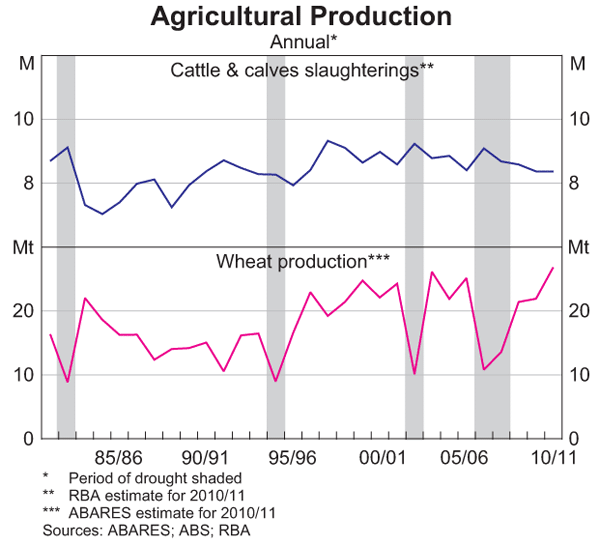
Conclusion
Despite declining relative to other sectors in the economy, the farm sector still plays an important role in determining the nation's pattern of economic growth. After a challenging decade, farm production is expected to increase solidly in 2010/11, with an increase in crop production offsetting a softer outlook for livestock. However, recent flooding in eastern Australia and potential damage from locusts are downside risks to the outlook for farm production. Following high rainfall, inflows to the Murray-Darling basin have increased in 2010 to above-average levels. This follows a decade when inflows were the lowest in recorded history and the nation experienced two severe droughts.
The composition of farm production has shifted somewhat towards cropping over the past two decades, with crops now accounting for over half of farm output. Moreover, there have been considerable changes within the cropping and livestock sub-industries in response to changes in relative prices, changing preferences and technological advancements. In particular, the cropping mix has shifted away from grains in favour of other crops, while the livestock-related sector has moved towards a greater focus on meat and dairy production, with wool production declining sharply over the past couple of decades.
The compositional shift in farm production towards crops and away from livestock has implications for how drought affects overall farm output. The production of crops tends to fall and recover sharply as a result of drought, as the area sown and the crop yield usually fall and rise in line with seasonal conditions. Production in the livestock industries tends to fall less sharply in drought years as farmers can use supplementary feed to support production, and tend to increase the number of animals they cull, which supports the production of meat. As drought can leave these farmers with fewer animals that are less productive, the recovery of this industry tends to be protracted.
References
Martin P, T Van Mellor and S Hooper (2007), ‘Live Cattle Export Trade Importance to Northern and Southern Australian Beef Industries’, Australian Bureau of Agricultural and Resource Economics, Australian Beef 07.1. Available at <http://www.abare.gov.au/publications_html/livestock/livestock_07/beef07.pdf>.
Nossal K, Y Sheng and S Zhao (2008), ‘Productivity in the Beef Cattle and Slaughter Lamb Industries’, Australian Bureau of Agricultural and Resource Economics, Research Report 08.13.